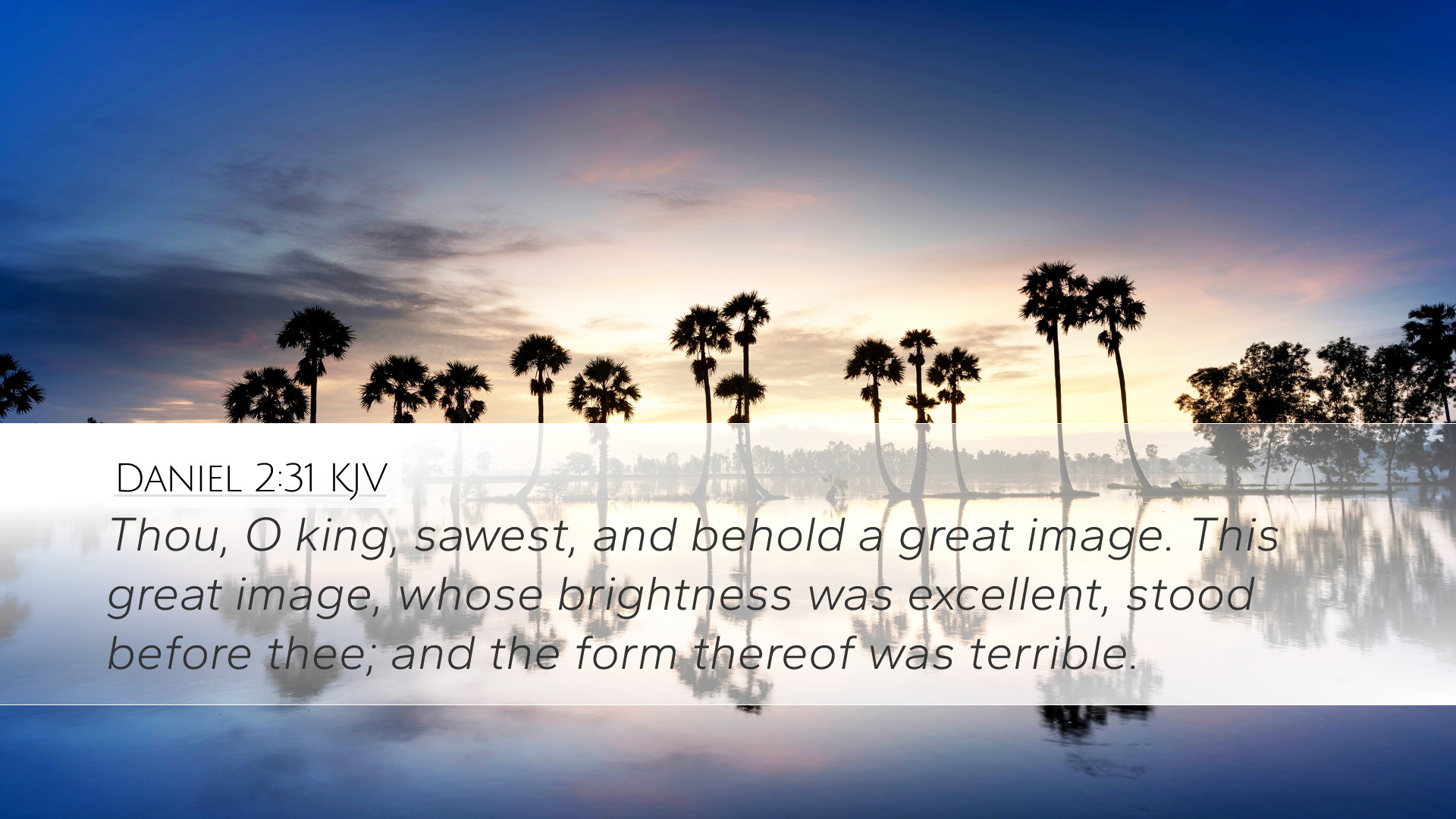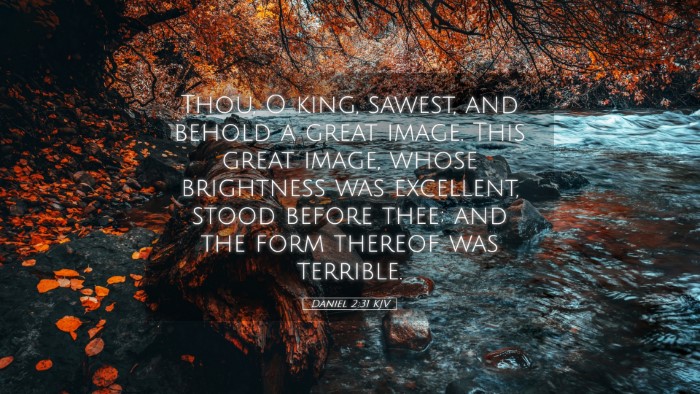Commentary on Daniel 2:31
Daniel 2:31 presents a pivotal moment in the narrative of Nebuchadnezzar's dream, which serves as a prophetic revelation concerning the future of empires and the ultimate sovereignty of God. This verse states:
"Thou, O king, sawest, and behold a great image."
Understanding the Great Image
In this verse, Daniel addresses King Nebuchadnezzar, drawing his attention to the image he saw in his dreams. The visual and symbolic nature of the image serves a greater purpose in revealing the divine plan for the kingdoms of the earth.
- Symbolism of the Image: The great image described serves as a representation of the kingdoms that would arise in succession. According to Matthew Henry, each part of the image correlates to a different empire, symbolizing the transition of power from one kingdom to another.
- Divine Revelation: Daniel emphasizes that this dream is not merely a figment of the king's imagination, but a prophetic message from God Himself. Albert Barnes notes that the significance is that God is the ultimate ruler over these earthly kingdoms.
- The Role of the Dreamer: Daniel, as the interpreter, is not merely delivering a message but also asserting his role as God’s chosen servant. Adam Clarke highlights the importance of recognizing the source of wisdom in interpreting dreams and signs.
The Nature of the Revelation
The revelation of the great image is multifaceted. It serves not only as a visual representation of power but also as a commentary on the ephemeral nature of human kingdoms. Understanding this requires deep theological reflection.
- The Temporal vs. Eternal: The kingdoms represented in the image are temporary, inevitably being replaced by God's everlasting kingdom. This theme resonates throughout Scripture and is a cornerstone of Christian eschatology.
- Human Pride and Divine Control: The image reflects the pride of human rulers, but it also intends to showcase that God controls these transitions. Barnes remarks that the interpretation of this dream undermines the arrogance displayed by earthly kings, reminding them of their ultimate accountability to God.
Pastoral Applications
For pastors, this verse highlights essential truths about God’s sovereignty and the fleeting nature of human authority.
- Encouragement to Congregations: Pastors can use this passage to encourage believers who may feel overwhelmed by the political and social upheaval of the present age, proclaiming that God's kingdom is immutable.
- Call to Humility: The message invites leaders and congregants alike to remain humble under God's sovereignty, recognizing their positions are temporary and ultimately belong to God.
- Proclaiming the Gospel: The passage serves as a reminder of the importance of evangelism, encouraging believers to share the message of God's eternal kingdom amidst a world obsessed with earthly power.
Theological Insights
This verse opens the door to extensive theological discussions concerning God's plan for nations and humanity.
- The Sovereignty of God: The image serves to illustrate God’s sovereignty not only over Israel but over all nations, a point articulated by Henry as central to prophetic literature.
- Eschatological Significance: The vision is often interpreted through an eschatological lens, propelling discussions about the end times and the establishment of God's everlasting kingdom.
- Christological Fulfillment: Understanding the ultimate purpose of God’s sovereign plans leads to discussions about Jesus Christ, who is the stone cut without hands that shall break all earthly kingdoms (Daniel 2:34-35).
Conclusion
Daniel 2:31 encapsulates profound truths regarding human history, the transient nature of earthly authority, and above all, the sovereignty of God over all creation. For theologians and scholars, it provides fertile ground for exploring the intersections of prophecy, divine revelation, and eschatology. In a world where human authority often takes precedence, this verse serves as a powerful reminder of the ultimate authority of God and His eternal kingdom.
As we reflect on this passage, may we strive to discern the relevance of ancient prophecies for our contemporary context, allowing the text to shape our understanding of God's unfolding plan through history.


